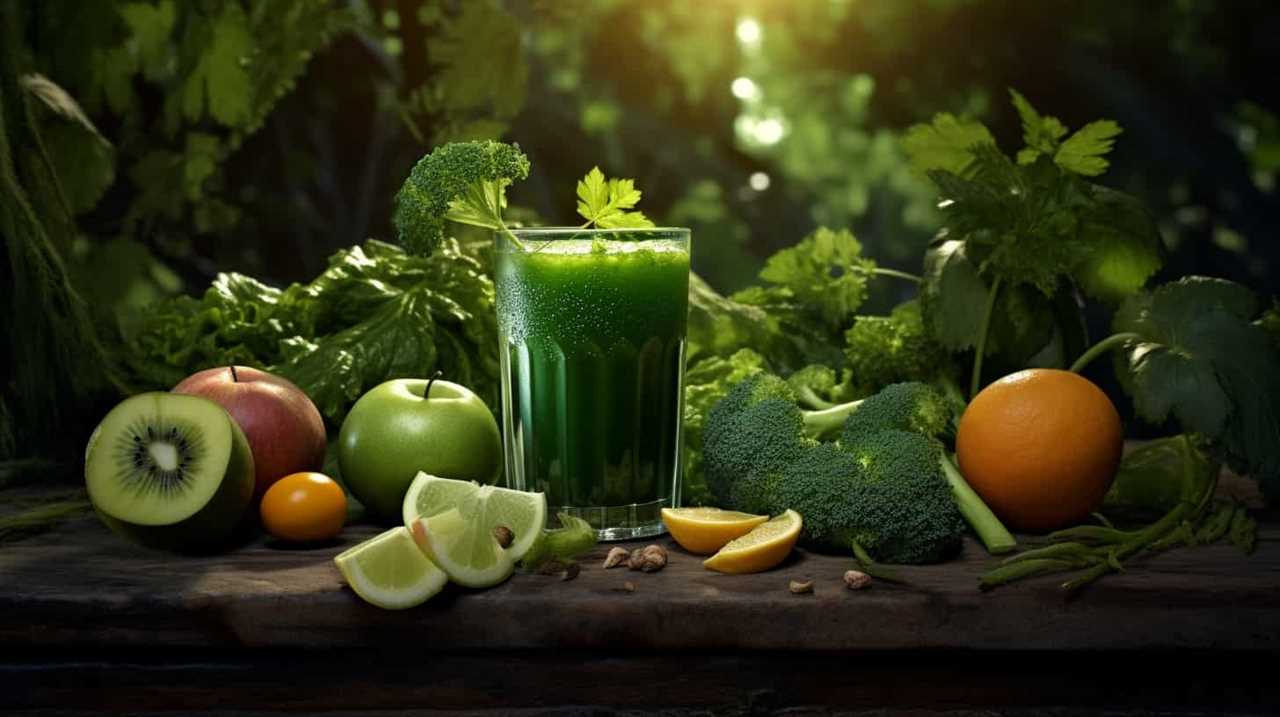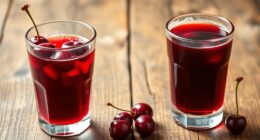Tired of the dull and lacking in nutrition vegetable juices sold in stores? We were too. That’s why we decided to focus on mastering the art of creating homemade vegetable juices.
Through trial and error, we discovered the perfect combination of vegetables, the best juicing method, and how to enhance the flavor and nutrition.
Join us on this journey as we share our knowledge and techniques for creating delicious and healthy vegetable juices that you can enjoy anytime.
Let’s get started!

Key Takeaways
- Consider the flavor profiles and health benefits of each vegetable when choosing the right vegetables for homemade vegetable juices.
- Use organic produce and thoroughly wash the vegetables to remove dirt, debris, and pesticide residue before juicing.
- Blend and strain the vegetables for optimal results, taking into account the differences between blending and juicing.
- Enhance the flavor and nutrition of vegetable juices by experimenting with different vegetable combinations, adding herbs and spices, and incorporating ingredients like citrus fruits, ginger, and turmeric.
Choosing the Right Vegetables
To create delicious and nutritious homemade vegetable juices, we must begin by carefully selecting the right vegetables. Choosing the right vegetables is essential in creating unique juice blends that not only taste great but also provide the necessary nutrients our bodies need.
When experimenting with different vegetable combinations, it’s important to consider the flavor profiles and health benefits of each vegetable. For example, carrots add sweetness, while leafy greens like kale and spinach provide a boost of vitamins and minerals. Cucumbers and celery contribute a refreshing and hydrating element to the juice. Additionally, root vegetables like beets and ginger can add depth and a hint of spice to the blend.
Preparing and Washing the Vegetables
We start by washing and preparing the vegetables to ensure they’re clean and ready for juicing. Here are three important steps to follow:
- Using organic produce: Opt for organic vegetables whenever possible to avoid harmful pesticides and chemicals. This not only ensures the vegetables are safer for consumption but also promotes sustainability and supports local farmers.
- Peeling and chopping: Thoroughly wash the vegetables under running water, using a vegetable brush if necessary. Remove any dirt, debris, or pesticide residue. Peel the vegetables if desired, but keep in mind that many nutrients are concentrated in the skin. Chop the vegetables into smaller pieces for easier juicing.
- Proper storage: After washing and chopping, it’s essential to store the vegetables correctly. Place them in airtight containers or zip-lock bags and refrigerate to maintain freshness and prevent spoilage.
With the vegetables prepared and clean, let’s now move on to selecting the best juicing method for optimal results.

Selecting the Best Juicing Method
For optimal results, we prefer juicing the vegetables using a combination of blending and straining methods. This method allows us to maximize the extraction of nutrients while achieving a smooth and enjoyable texture. Blending involves using a high-speed blender to break down the vegetables into a pulp, while juicing involves extracting the liquid from the pulp using a strainer or a juicer machine.
To help you understand the differences between blending and juicing, let’s compare them in the following table:
| Blending | Juicing |
|---|---|
| Retains fiber and pulp | Removes fiber and pulp |
| Quick and easy preparation | Longer preparation time |
| Thick and smooth texture | Thin and liquid consistency |
| Nutrient-rich and filling | Concentrated in vitamins and minerals |
While both methods have their advantages, cold press juicing is gaining popularity due to its unique benefits. Cold press juicing uses a slow, gentle process that minimizes heat and oxidation, preserving more nutrients and enzymes in the juice. It also yields a higher juice yield compared to traditional juicing methods. However, it’s important to note that cold press juicers can be more expensive and require more time for preparation and cleaning.
Enhancing the Flavor and Nutrition
In this section, we’ll explore ways to enhance the flavor and nutrition of homemade vegetable juices. By incorporating these tips, you can create delicious and nutrient-rich juice blends that won’t only boost your immune system but also satisfy your taste buds.

- Experiment with creative juice blends: Mix different vegetables together to create unique flavor combinations. For example, try blending carrots, ginger, and turmeric for a zesty immune-boosting juice.
- Add herbs and spices: Herbs like mint and basil, and spices like cinnamon and cayenne pepper, can add depth and complexity to your vegetable juices. They also offer additional health benefits.
- Include citrus fruits: Adding a splash of lemon or lime juice can brighten up the flavors of your vegetable juices and provide a dose of vitamin C.
By following these tips, you can create vegetable juices that aren’t only nutritious but also flavorful. Experimenting with different combinations of vegetables, herbs, and spices can help you discover your favorite blends. Start with simple ingredients like carrots, cucumbers, and spinach, then gradually incorporate bold flavors like ginger or garlic. With a little creativity, you’ll soon master the best homemade vegetable juice recipes that suit your taste and nutritional needs.
Now, let’s move on to the next section, where we’ll discuss storing and enjoying your vegetable juice.
Storing and Enjoying Your Vegetable Juice
After enhancing the flavor and nutrition of our homemade vegetable juices, let’s now explore how to store and enjoy them. Proper storage is crucial to maintain the freshness and quality of your juices. Here are some long term preservation techniques you can use:
- Freezing: Pour your vegetable juice into airtight containers or ice cube trays and freeze them. This method helps preserve the nutrients and extends the shelf life.
- Canning: If you prefer a more shelf-stable option, consider canning your vegetable juice. Follow proper canning procedures to ensure safety and longevity.
Now, let’s move on to creative serving suggestions to make your vegetable juice experience even more enjoyable. Here are some ideas:

- Mix and match: Combine different vegetable juices to create unique flavor combinations.
- Infuse with herbs and spices: Add a dash of fresh herbs or spices to enhance the taste profile of your vegetable juice.
- Serve chilled: Refrigerate your vegetable juice before serving to enhance the refreshing factor.
Frequently Asked Questions
Can I Use Frozen Vegetables Instead of Fresh Ones?
Yes, we can use frozen vegetables instead of fresh ones. However, there may be some nutritional differences between the two. Fresh vegetables tend to retain more nutrients, but frozen vegetables can still provide essential vitamins and minerals.
Is It Necessary to Peel the Vegetables Before Juicing Them?
Peeling vegetables before juicing is not necessary. In fact, leaving the peel on can provide additional nutrients and fiber. Some of the best vegetables to juice with the peel on include carrots, cucumbers, and apples.
Can I Mix Fruits With Vegetables in My Homemade Juices?
Yes, we can mix fruits with vegetables in our homemade juices. Incorporating fruits adds sweetness and a variety of nutrients to vegetable juices, enhancing their taste and health benefits.
How Long Can I Store Homemade Vegetable Juice in the Refrigerator?
We store homemade vegetable juice in airtight containers in the refrigerator. Glass jars with lids or BPA-free plastic containers work best. It’s important to consume the juice within 3-4 days for optimal freshness and nutrients.

Is It Possible to Freeze Vegetable Juice for Later Use?
Yes, it’s possible to freeze vegetable juice for later use. Freezing benefits include preserving nutrients and extending shelf life. Alternatively, you can also store homemade vegetable juice in airtight containers in the refrigerator for a few days.
Conclusion
In conclusion, mastering the art of homemade vegetable juices is an exciting and rewarding journey. By choosing the right vegetables, preparing them properly, and selecting the best juicing method, you can create flavorful and nutritious juices that will benefit your health.
Don’t miss out on this incredible opportunity to unleash your creativity and enhance your well-being with the power of homemade vegetable juices. It’s like a taste explosion in every sip, taking your health to new heights!
Susannah expertise lies in researching and compiling evidence-based content on juicing, nutrition, and overall health. She is committed to ensuring that The Juicery World offers accurate, up-to-date, and trustworthy information to empower readers to take control of their health. Susannah’s goal is to inspire individuals to embrace juicing as a way to nourish their bodies and live their best lives.











